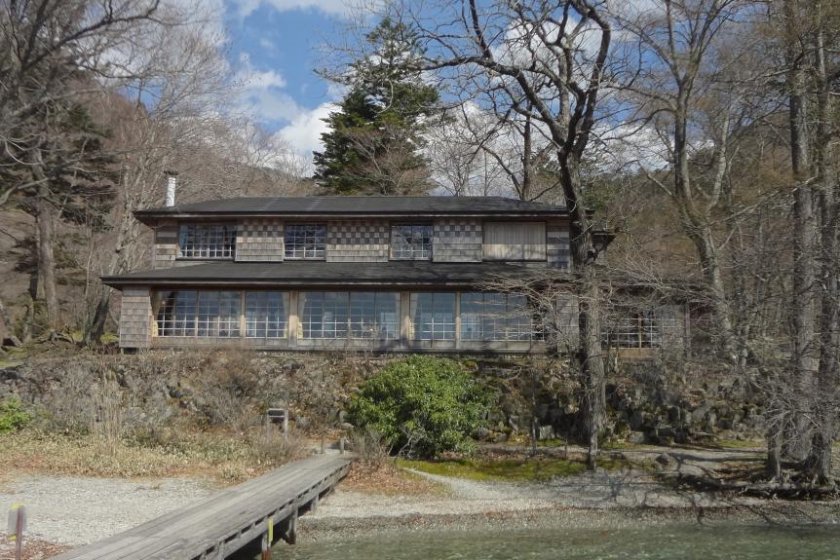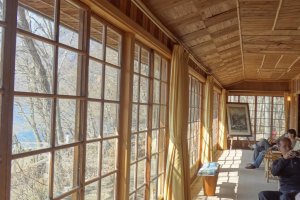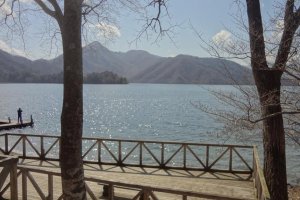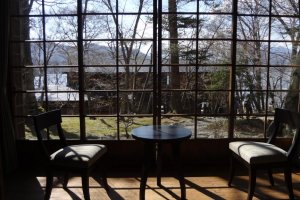The former Italian Embassy Villa in Nikko is now open to the public as a park. After Tochigi prefecture bought it quite recently, the building was repaired and restored. Designed by American architect Antonin Raymond, the villa was built in 1928. It was used by successive generations of Italian ambassadors and their families as a summering place. The villa was so comfortable and had such a nice view of the lake and mountains that the ambassador’s wife and kids spent much more time there than the ambassador could. He always had to come back to Tokyo much earlier!
The surrounding landscape
The villa is on the eastern shore of Chuzen-ji Lake—about a 30-minute walk from the Tachiki-kannon Iriguchi (立木観音入口) bus stop. Chuzen-ji Temple is halfway to the villa. As you walk along the trail, Chuzen-ji Lake will always be on your right. You can see some other Embassy villas along the road: French, Belgian, and British. In the old days, people said that in the hot, humid summer, most foreign Embassies escaped from Tokyo to Nikko.
Upon reaching the villa, you feel more comfortable walking among trees. Strolling along the meandering path inside the villa-park grounds, you’ll reach the lakeside. There is a private pier and a wide wooden deck affording a perfect view of the picturesque mountains standing in the distance in front of the villa.
Main villa
The exterior of the building is checkered with Japanese cedar bark. The designer, Raymond, was good at using local materials and he utilized Nikko cedar and bamboo in various ways on the walls. The first floor is a public space, consisting of a dining room, living room and study. A wide veranda facing the lake is the most attractive spot. Leaning back on the sofa, reading books, and sometimes watching the shining lake and drifting clouds must have been an absolute luxury. There are three bedrooms on the second floor. These private spaces must have also been wonderful.
Antonin Raymond
Antonin Raymond was born in Kladono, Czech Republicin 1888. His given name was Antonín Reimann. He studied architect at Czech Technical University and then moved to the U.S. in 1910. In 1916 he acquired American citizenship and changed his family name to Raymond. He came to Japan accompanying Frank Lloyd Wright for the design of the Imperial Hotel in Tokyo. Raymond established his own office in 1922 and created a unique style in architecture. He designed the Ehrismann Residence in Yokohama in 1926 and this Italian Embassy Villa in Nikko in 1928. A big sweets company, Fujiya, has a building in Isezaki-cho, Yokohama. It is another Raymond design in Yokohama. After WWII, the GHQ requisitioned the building and used it as a club. Yokohama Club was the name we can see from photos of that time.
Raymond left Japan once in 1937 and came back in 1948. He had a tremendous impact on modern Japanese architecture. His buildings were beautiful, and at the same time, very practical. They also harmonized well with their surroundings. Japanese architects learned a lot from him.
Raymond eventually retired and settled down in New Hope, Pennsylvania, in 1973. Three years later, he passed away at age 88.
I didn’t realize until I began researching Raymond that several buildings that have impressed me in my life, (in Niigata, Nagano, and Gunma) were all designed by him: the Peynet museum and St. Paul’s Catholic Church in Karuizawa, Nagano; the Catholic Shibata Church in Niigata; and the Gunma Music Hall in Takasaki, Gunma. If you have a chance to visit any of those places, please take a look at them. They are all ideal matches for their surroundings, in much the same way as Raymond’s Italian Embassy Villa is in Nikko.



































